Veterinarians are always on the lookout for novel therapies that can help the animals under their care recover from trauma and disease. One such innovation is the hyperbaric pet oxygen chamber, a device that has surprising efficacy in assisting animals in returning to health following injury, accidental ingestion of food, problems with the lungs and even skin ailments.
Interested in offering hyperbaric oxygen treatment at your veterinarian clinic?
Call: 850-510-2781
What Is Hyperbaric Oxygen Therapy?
Hyperbaric oxygen therapy is a well-established and scientifically proven therapy for dealing with a wide range of medical conditions. Historically, doctors have used it to treat patients with decompression sickness — a condition affecting divers who return to the surface too quickly. However, in recent years vets have discovered its usefulness in treating a range of conditions experienced by animals in their care.
The way hyperbaric medicine works is simple. The vet places the affected animal inside a chamber filled with oxygen. Special machinery then increases the pressure in the chamber to around three atmospheres – or three times the pressure at sea level. The animal then remains in the chamber for the duration of the treatment, usually around two hours.
The Benefits Of Hyperbaric Oxygen Therapy For Pets
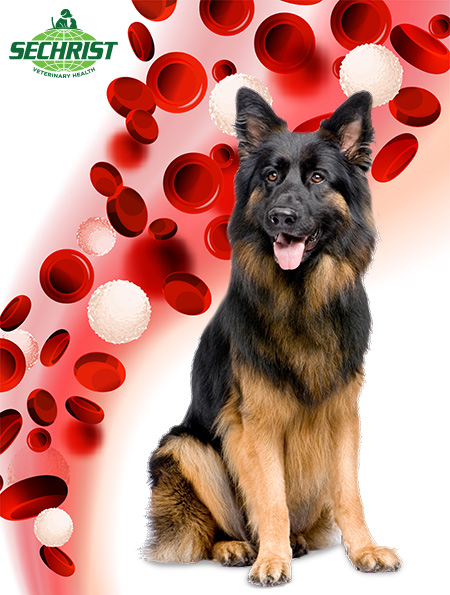 Hyperbaric oxygen therapy or HBOT has assumed an ever-expanding role in modern medicine practices-for both humans and pets. In veterinary medicine, hyperbaric oxygen therapy continues to demonstrate its effectiveness in primary and adjunctive care. It offers significant medical benefits through enhanced wound healing, improved infection control, and preservation of damaged tissues; plus several more. It also helps alleviate the growing number of complicated, expensive or otherwise hopeless medical problems.
Hyperbaric oxygen therapy or HBOT has assumed an ever-expanding role in modern medicine practices-for both humans and pets. In veterinary medicine, hyperbaric oxygen therapy continues to demonstrate its effectiveness in primary and adjunctive care. It offers significant medical benefits through enhanced wound healing, improved infection control, and preservation of damaged tissues; plus several more. It also helps alleviate the growing number of complicated, expensive or otherwise hopeless medical problems.
It Improves The Supply Of Oxygen To Affected Tissues
It is important to note that the benefits of HBOT result from an oxygen-enriched bloodstream and not from the oxygen’s direct contact with the wound. The addition of oxygen into the blood increases the oxygen diffusion distance from the functioning capillaries in a hyperfocused wound to cause stimulation of growth resulting in wound healing. Using a pressurized oxygen chamber to treat an animal helps improve the flow of oxygen to different parts of a pet’s body and dramatically elevates the amount of oxygen delivered to the body’s tissues by the blood.
It Can Treat A Wide Range Of Conditions
Over recent years, the use of HBOT in clinical use has progressed causing it to be an advantageous form of medicine.
It offers a copious amount of advantages to veterinarians and their patients including a growing number of allowed treatable indications. Such as peripheral neuropathies, pancreatitis, inflammatory diseases, snake bites, and many more. For an extensive list of permitted indications, please visit our About HBOT page or click here: http://bit.ly/SiVetHealth
Pet Oxygen Chamber Treatments are Affordable
Not only is HBOT a rapid and effective treatment, but it is also remarkably affordable compared to many conventional procedures. In comparison to surgery or more complicated treatments, HBOT is inexpensive, easy and straightforward. Animals are merely placed in a pressurized container with a blanket and allowed to recover. For comparison, it is no more expensive than acupuncture or laser treatments.
It Is Relaxing For The Animals
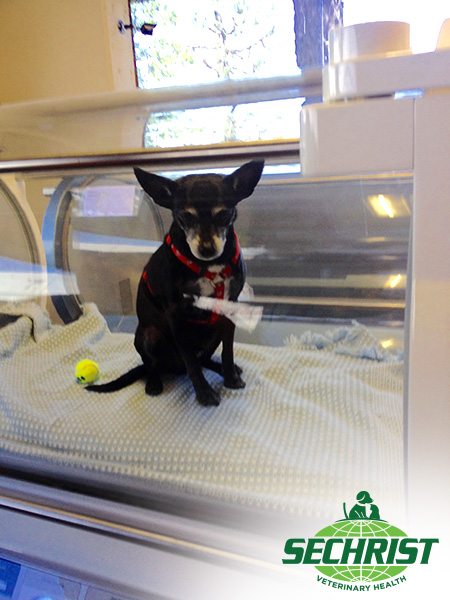 Unlike many procedures, HBOT chambers provide pets with a relaxing and peaceful environment. Many of them enjoy the treatment. Also, Sechrist’s hyperbaric oxygen chambers are made with a clear acrylic cylinder and come with clear modules for easy monitoring. The clear acrylic of both the chamber and module aids in keeping an animal calm and collected by allowing them to see their surrounding environment and the technician seated outside the chamber.
Unlike many procedures, HBOT chambers provide pets with a relaxing and peaceful environment. Many of them enjoy the treatment. Also, Sechrist’s hyperbaric oxygen chambers are made with a clear acrylic cylinder and come with clear modules for easy monitoring. The clear acrylic of both the chamber and module aids in keeping an animal calm and collected by allowing them to see their surrounding environment and the technician seated outside the chamber.
It Can Speed Up The Healing Process
One way a pet oxygen chamber works is by speeding up the process of healing. The chamber completes this process by increasing the amount of oxygen running through the animal’s body to help deliver vital nutrients to cells. Cells then use the additional oxygen to go about their repair processes, ensuring that the animal heals quicker.. Extra oxygen encourages the release of growth factors and stem cells that make the healing process faster.
Should You Use HBOT For The Pets In Your Care?
Considering HBOT has a growing number of indications for clinical use and decreases the time it takes or an animal to heal, a veterinarian can increase the number of animals they treat. Making an HBOT chamber a very viable investment choice for one’s practice.
For many animal owners, hyperbaric oxygen therapy is far more preferable to other forms of treatment, such as surgery. Just like people, it can take pets many weeks, if not months, to recover after going under the knife. HBOT can potentially negate the need for surgery or could help surgical wounds heal quickly and naturally.
Many veterinarians today are considering HBOT for their clients due to the many benefits it provides to both pets and their owners. Plus SV500 hyperbaric animal chambers have a dual purpose ICU functionality that allows you to deliver both hyperbaric oxygen therapy and enhanced O2 oxygen therapy at ambient pressure. It is operator friendly with indicators and operational flexibility. Furthermore, the installation of HBOT systems is easy. A trained technician installs the chamber with the provided adapters and hoses while maximizing space by conveniently locating all connections in the back of the chamber.
Increased Pressure Leads To Anti-Inflammatory Gene Expression
Leading the list of HBOT benefits is the effect higher pressures have on the genome. When vets expose animal tissue to higher pressures, it induces changes in the epigenome, down regulating inflammatory genetic expression — resulting in a critical synergistic therapeutic method for reducing inflammation. This reduction in inflammation has implications for treating animals with both trauma and pathogen-caused disease.
Better Oxygen Delivery To Trauma Sites And Injuries
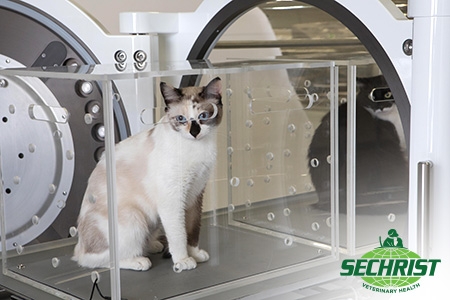 When trauma or crush injury occurs, there can be a reduction in blood flow and swelling to the area. By placing pets in an HBOT chamber breathing 100% oxygen, veterinarians can increase oxygen tension levels by 10 to 20 times that of normobaric oxygen breathing. This level increase in oxygen tension allows for faster and better healing of the animal.
When trauma or crush injury occurs, there can be a reduction in blood flow and swelling to the area. By placing pets in an HBOT chamber breathing 100% oxygen, veterinarians can increase oxygen tension levels by 10 to 20 times that of normobaric oxygen breathing. This level increase in oxygen tension allows for faster and better healing of the animal.
Rapid Removal Of Carbon Monoxide From Blood Cells
Pets can suffer carbon monoxide poisoning just like people. When carbon monoxide poisoning happens, it’s vital to unbind the CO molecule from the red blood cells as fast as possible. Evidence suggests that HBOT may help this process by rapidly removing carbon monoxide molecules from hemoglobin and deliver dissolved oxygen via plasma.
Reduction In Toxin Formation By Gangrene Pathogens
Lastly, HBOT appears to inhibit the ability of the gangrene causing pathogen that prompts the release of deadly toxins. Pets, therefore, undergoing HBOT treatment may benefit from being placed in an oxygen chamber.
As chamber technology advances and HBOT treatments gain notoriety vets must expand their knowledge on potential indications. Staying up to date can help give animal patients the best possible care by providing access to the finest treatments on the market.
With the application of HBOT treatments in both clinical and adjunctive care, veterinary medicine is only going to improve further and develop.
Shouldn’t your practice be at the forefront of hyperbaric medicine?
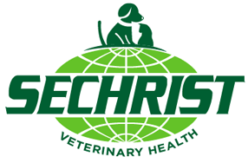
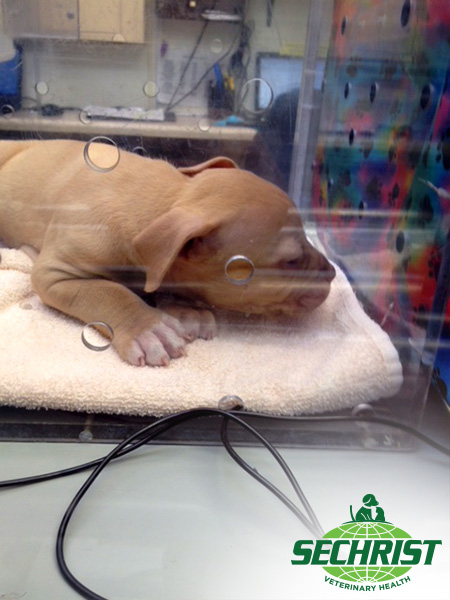 While HBOT may often be automatically associated with humans, it’s important to bear in mind there are many potential applications for pets, including in the improvement of food aspiration symptoms.
While HBOT may often be automatically associated with humans, it’s important to bear in mind there are many potential applications for pets, including in the improvement of food aspiration symptoms. 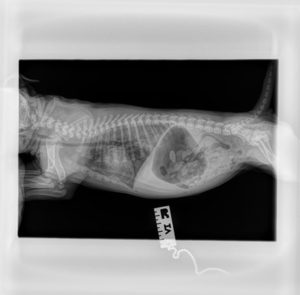 While HBOT for pets is a relatively new therapy, it has seen proven success as an adjunctive medicine. Take the following case study as an example. A 5-week-old female puppy was presented after it was discovered in respiratory arrest immediately after accidental ingestion of a large piece of dry dog food kibble. The owner cleared the oral cavity with her finger then performed chest compressions until the puppy began spontaneous respirations. The puppy was dyspneic, tachypneic, and cyanotic on presentation, and had increased pulmonary bronchovesicular sounds in all lung fields. Admitting radiographs revealed non-cardiogenic pulmonary edema.
While HBOT for pets is a relatively new therapy, it has seen proven success as an adjunctive medicine. Take the following case study as an example. A 5-week-old female puppy was presented after it was discovered in respiratory arrest immediately after accidental ingestion of a large piece of dry dog food kibble. The owner cleared the oral cavity with her finger then performed chest compressions until the puppy began spontaneous respirations. The puppy was dyspneic, tachypneic, and cyanotic on presentation, and had increased pulmonary bronchovesicular sounds in all lung fields. Admitting radiographs revealed non-cardiogenic pulmonary edema.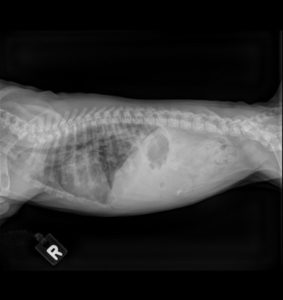 Over the following 24 hours, the puppy was treated with two more HBOT sessions, and transitioned back to room air, 21%, free flow at sea level pressure.
Over the following 24 hours, the puppy was treated with two more HBOT sessions, and transitioned back to room air, 21%, free flow at sea level pressure.